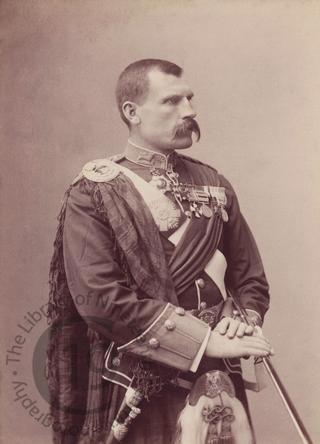
Major-General Sir Hector MacDonald
A cabinet card portrait of Hector MacDonald (1853-1903), one of only a few soldiers in the British Army to have risen all the way through the ranks on his own merits. He became a popular hero in Scotland and England and was knighted for his service in the Second Boer War. Posted to Ceylon [modern-day Sri Lanka] as the Commander-in-Chief of the British forces, he committed suicide in 1903 rather than face a public enquiry into his homosexual activity with local boys.
Born the son of a crofter in 1852, at Malbuie near Muir of Ord, he enlisted in the 92nd Gordon Highlanders as a private when he was 17 years old. For his distinguished conduct in the face of the enemy during the Second Afghan War, he was offered a choice between the Victoria Cross or the opportunity to jump the chasm that existed between non-commissioned and commissioned officers. He chose the latter, eventually rising to the rank of Major-General, and in 1901 he was knighted for his services at Omdurman and in South Africa. The following year he was appointed Commander-in-Chief of the British forces in Ceylon. Unfortunately, this posting proved his undoing. As one historian has pointed out: ‘Ceylon furnished MacDonald with a lethal combination of a military command which was inactive and uninteresting, and a community of boys who were interesting and very active' (Ronald Hyam, Empire and Sexuality: The British Experience, 1990). Travelling back from London to Ceylon to face a court martial, MacDonald shot himself in a hotel room in Paris when he read details of the scandal in an American newspaper.
‘Fighting Mac’ remained a hero in Scotland, the Scots convincing themselves that the charges were all a conspiracy trumped up by the establishment in Ceylon, who supposedly resented having the son of a crofter lording it over them. This is despite the 70 witnesses who were ready to give evidence against MacDonald and despite the fact that there had already been rumours of his homosexuality during previous postings in South Africa and India. All the evidence in the case was destroyed long ago, so we’ll never know for certain one way or the other.
Photographed by William Heath of Plymouth.
Code: 126011




